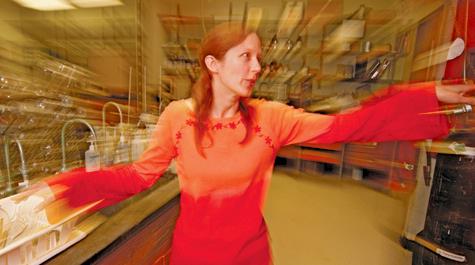LiveScience showcases W&M photochemist
A story featuring a William and Mary chemist's work with highly colored molecules has been featured on the LiveScience web site, in cooperation with the National Science Foundation (NSF).
Headlined "The Choreography of Dancing Molecules," the story describes interesting work under way in the lab of Elizabeth Harbron, associate professor of chemistry. Harbron is leading a team investigating the properties of conjugated polymers, long-chain molecules that under certain conditions can be made to glow—even change colors—on demand.
Conjugated polymers are used in biological switches and show a great deal of potential for the development of a new generation of displays for laptop monitors and screens on devices like cell phones and other electronics. The NSF is supporting Harbron's research with a five-year CAREER award through the NSF's Organic and Macromolecular Chemistry Program.
"This kind of exposure is important for the work of our researchers," said James Golden, vice president for strategic initiatives at William and Mary. "We need open lines of communication with agencies that fund our research. We want to keep them informed about the results in a variety of ways beyond formal reports. These stories are an effective way to show, in a very personal way, just how important their funding and the resulting research are to us and to the people of the nation and the world.”
The LiveScience story is an edited version of a piece that originally appeared in the summer, 2007 issue of Ideation, the research and scholarship magazine of William and Mary. Harbron and her group are continuing their investigation of conjugated polymers from their larger and better-equipped lab in the College's new Integrated Science Center.
The NSF has a fruitful collaboration with LiveScience, according to Joshua Chamot, media officer at the National Science Foundation, and a 1998 William and Mary graduate with a double major in music and geology.
"A lot of times, stories about scientists or engineers get framed in certain ways," Chamot explained. "Stereotypes are applied or views are pigeonholed. The idea here is to give a little bit of behind-the-scenes background on what they actually do day-to-day."
Chamot said the NSF solicited stories from its 10,000 awardees. Selected stories are submitted to LiveScience, usually with minor edits, he said.
"We posted our first item a little over a year ago, and we’ve been posting them almost every week since. They get a lot of coverage on the LiveScience site. These stories get thousands of visits," Chamot said. "LiveScience will also redistribute the stories to Yahoo News and some of their other syndication partners. We find that people are really excited about these stories. They get a real perspective on what it is like to be a researcher."
 Skip to main content
Skip to main content

